maintenance TOYOTA RAV4 1996 Service Repair Manual
[x] Cancel search | Manufacturer: TOYOTA, Model Year: 1996, Model line: RAV4, Model: TOYOTA RAV4 1996Pages: 1632, PDF Size: 41.64 MB
Page 943 of 1632
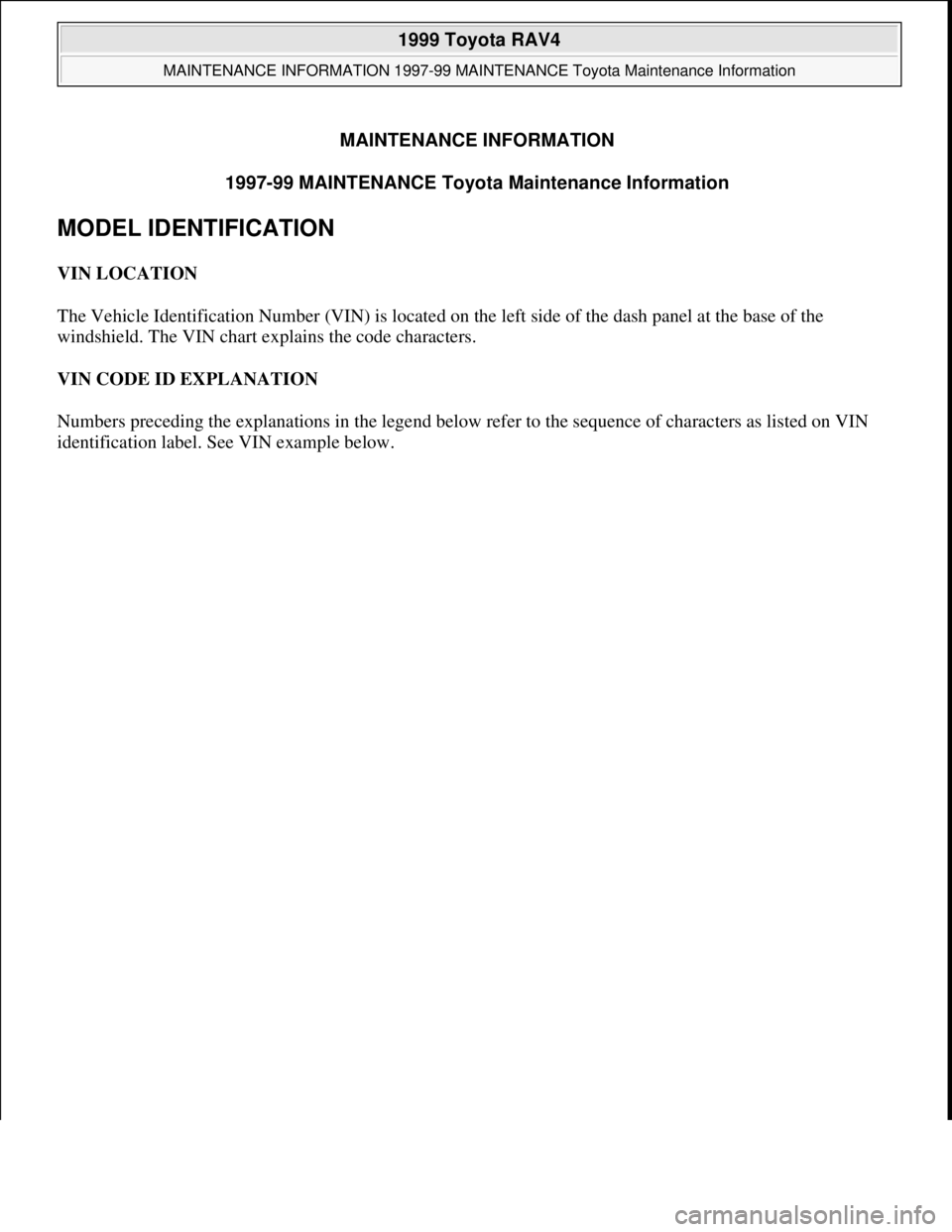
MAINTENANCE INFORMATION
1997-99 MAINTENANCE Toyota Maintenance Information
MODEL IDENTIFICATION
VIN LOCATION
The Vehicle Identification Number (VIN) is located on the left side of the dash panel at the base of the
windshield. The VIN chart explains the code characters.
VIN CODE ID EXPLANATION
Numbers preceding the explanations in the legend below refer to the sequence of characters as listed on VIN
identification label. See VIN example below.
1999 Toyota RAV4
MAINTENANCE INFORMATION 1997-99 MAINTENANCE Toyota Maintenance Information
1999 Toyota RAV4
MAINTENANCE INFORMATION 1997-99 MAINTENANCE Toyota Maintenance Information
Microsoft
Sunday, November 22, 2009 10:32:41 AMPage 1 © 2005 Mitchell Repair Information Company, LLC.
Microsoft
Sunday, November 22, 2009 10:32:49 AMPage 1 © 2005 Mitchell Repair Information Company, LLC.
Page 944 of 1632
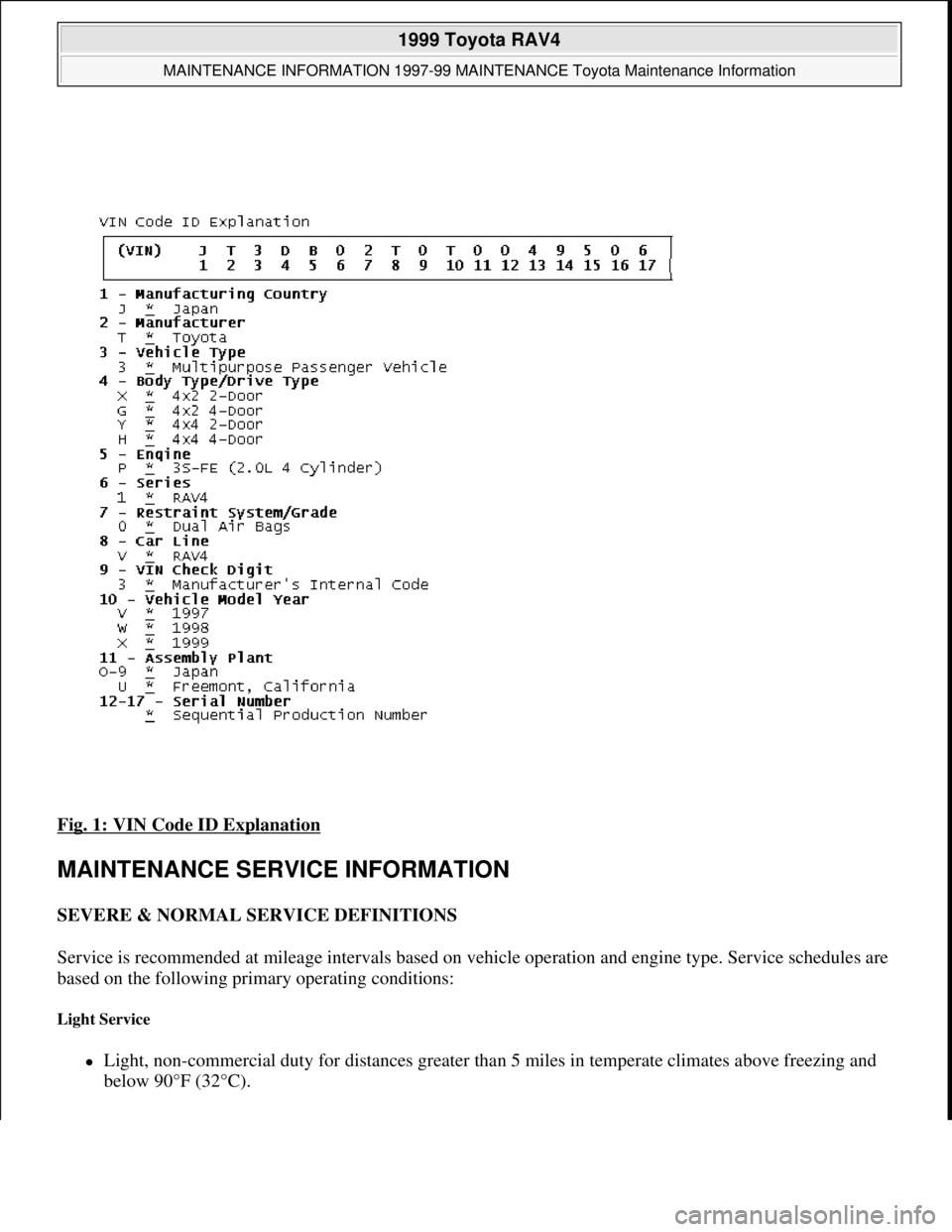
Fig. 1: VIN Code ID Explanation
MAINTENANCE SERVICE INFORMATION
SEVERE & NORMAL SERVICE DEFINITIONS
Service is recommended at mileage intervals based on vehicle operation and engine type. Service schedules are
based on the following primary operating conditions:
Light Service
Light, non-commercial duty for distances greater than 5 miles in temperate climates above freezing and
below 90°F (32°C).
1999 Toyota RAV4
MAINTENANCE INFORMATION 1997-99 MAINTENANCE Toyota Maintenance Information
Microsoft
Sunday, November 22, 2009 10:32:41 AMPage 2 © 2005 Mitchell Repair Information Company, LLC.
Page 945 of 1632
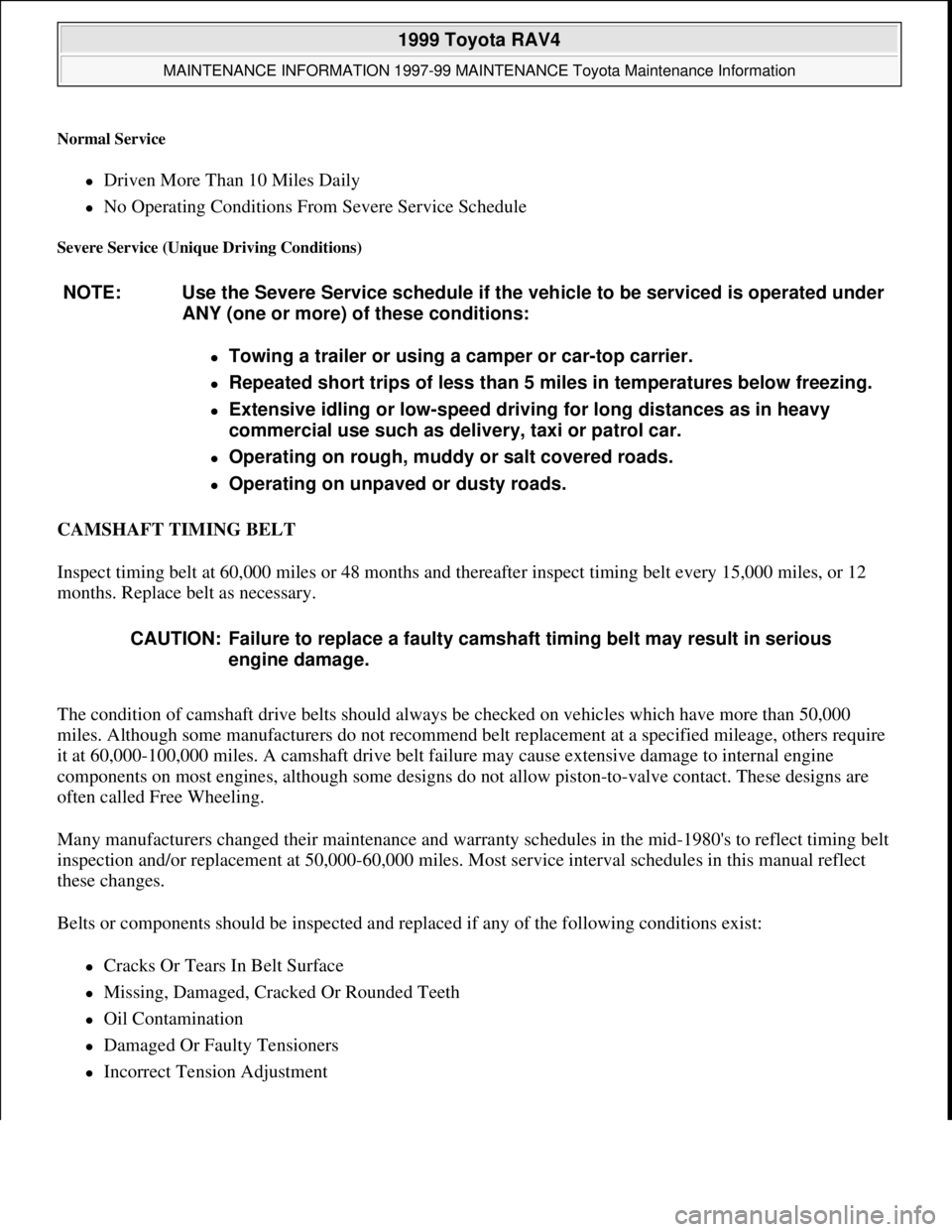
Normal Service
Driven More Than 10 Miles Daily
No Operating Conditions From Severe Service Schedule
Severe Service (Unique Driving Conditions)
CAMSHAFT TIMING BELT
Inspect timing belt at 60,000 miles or 48 months and thereafter inspect timing belt every 15,000 miles, or 12
months. Replace belt as necessary.
The condition of camshaft drive belts should always be checked on vehicles which have more than 50,000
miles. Although some manufacturers do not recommend belt replacement at a specified mileage, others require
it at 60,000-100,000 miles. A camshaft drive belt failure may cause extensive damage to internal engine
components on most engines, although some designs do not allow piston-to-valve contact. These designs are
often called Free Wheeling.
Many manufacturers changed their maintenance and warranty schedules in the mid-1980's to reflect timing belt
inspection and/or replacement at 50,000-60,000 miles. Most service interval schedules in this manual reflect
these changes.
Belts or components should be inspected and replaced if any of the following conditions exist:
Cracks Or Tears In Belt Surface
Missing, Damaged, Cracked Or Rounded Teeth
Oil Contamination
Damaged Or Faulty Tensioners
Incorrect Tension Adjustment NOTE: Use the Severe Service schedule if the vehicle to be serviced is operated under
ANY (one or more) of these conditions:
Towing a trailer or using a camper or car-top carrier.
Repeated short trips of less than 5 miles in temperatures below freezing.
Extensive idling or low-speed driving for long distances as in heavy
commercial use such as delivery, taxi or patrol car.
Operating on rough, muddy or salt covered roads.
Operating on unpaved or dusty roads.
CAUTION: Failure to replace a faulty camshaft timing belt may result in serious
engine damage.
1999 Toyota RAV4
MAINTENANCE INFORMATION 1997-99 MAINTENANCE Toyota Maintenance Information
Microsoft
Sunday, November 22, 2009 10:32:41 AMPage 3 © 2005 Mitchell Repair Information Company, LLC.
Page 946 of 1632
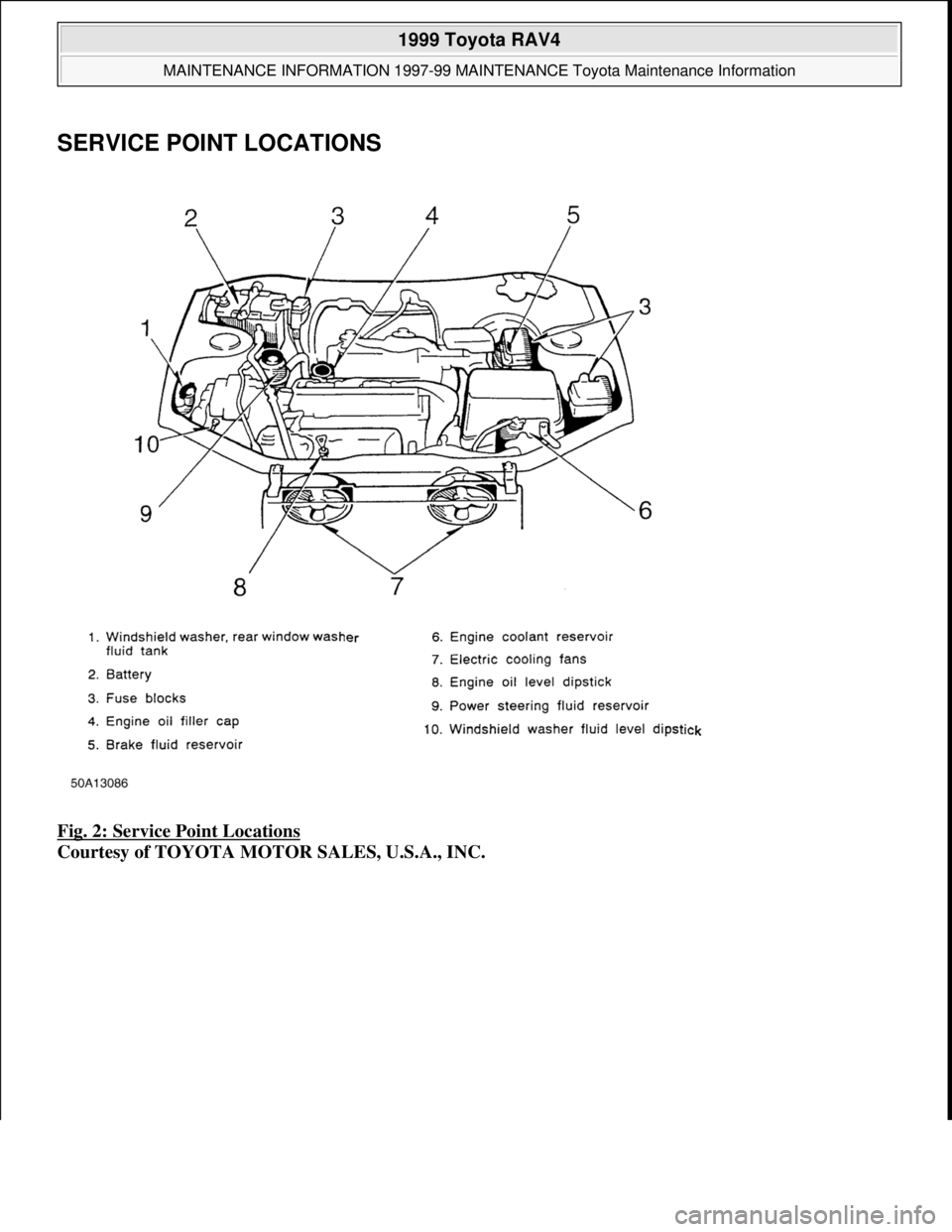
SERVICE POINT LOCATIONS
Fig. 2: Service Point Locations
Courtesy of TOYOTA MOTOR SALES, U.S.A., INC.
1999 Toyota RAV4
MAINTENANCE INFORMATION 1997-99 MAINTENANCE Toyota Maintenance Information
Microsoft
Sunday, November 22, 2009 10:32:42 AMPage 4 © 2005 Mitchell Repair Information Company, LLC.
Page 947 of 1632
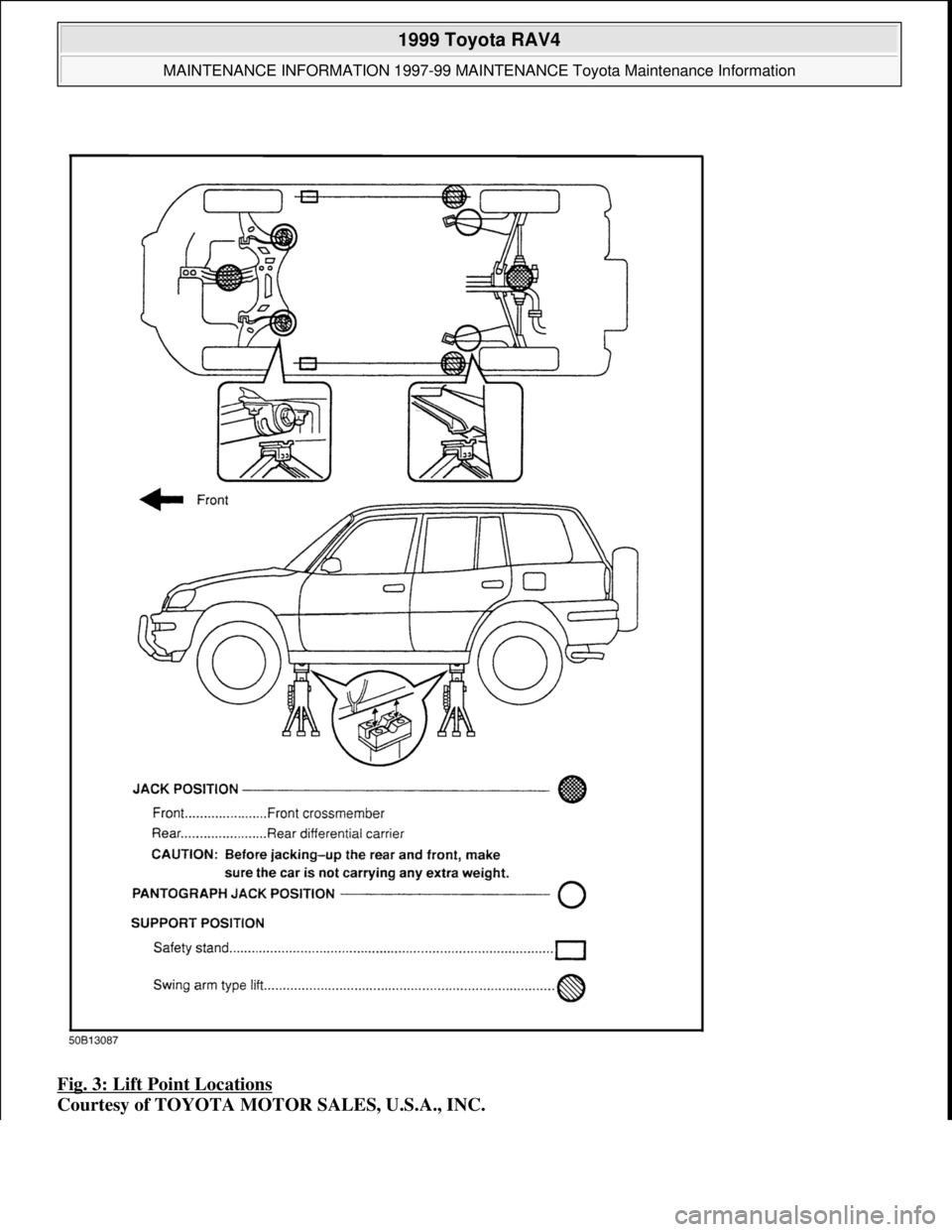
Fig. 3: Lift Point Locations
Courtesy of TOYOTA MOTOR SALES, U.S.A., INC.
1999 Toyota RAV4
MAINTENANCE INFORMATION 1997-99 MAINTENANCE Toyota Maintenance Information
Microsoft
Sunday, November 22, 2009 10:32:42 AMPage 5 © 2005 Mitchell Repair Information Company, LLC.
Page 948 of 1632
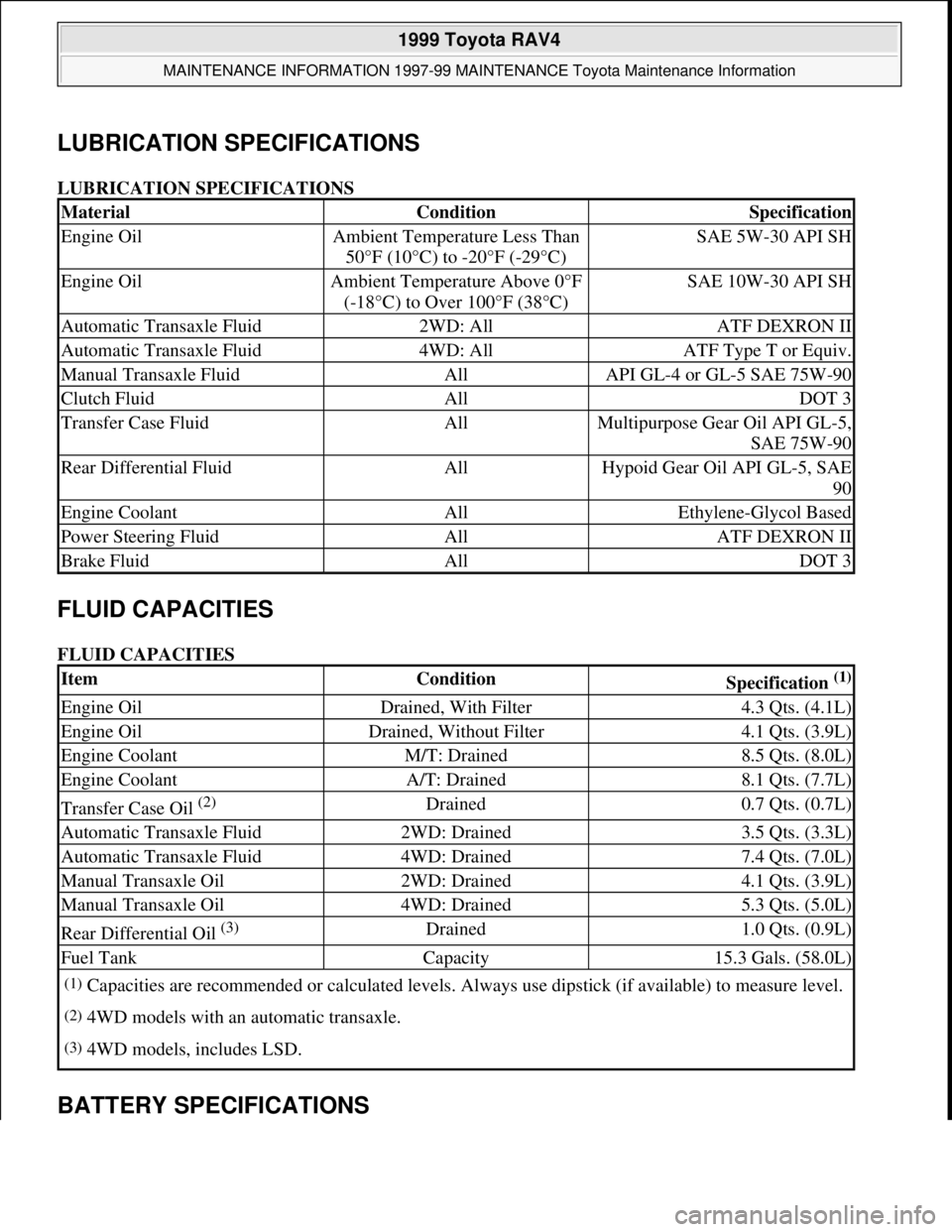
LUBRICATION SPECIFICATIONS
LUBRICATION SPECIFICATIONS
FLUID CAPACITIES
FLUID CAPACITIES
BATTERY SPECIFICATIONS
MaterialConditionSpecification
Engine OilAmbient Temperature Less Than
50°F (10°C) to -20°F (-29°C)SAE 5W-30 API SH
Engine OilAmbient Temperature Above 0°F
(-18°C) to Over 100°F (38°C)SAE 10W-30 API SH
Automatic Transaxle Fluid2WD: AllATF DEXRON II
Automatic Transaxle Fluid4WD: AllATF Type T or Equiv.
Manual Transaxle FluidAllAPI GL-4 or GL-5 SAE 75W-90
Clutch FluidAllDOT 3
Transfer Case FluidAllMultipurpose Gear Oil API GL-5,
SAE 75W-90
Rear Differential FluidAllHypoid Gear Oil API GL-5, SAE
90
Engine CoolantAllEthylene-Glycol Based
Power Steering FluidAllATF DEXRON II
Brake FluidAllDOT 3
ItemConditionSpecification (1)
Engine OilDrained, With Filter4.3 Qts. (4.1L)
Engine OilDrained, Without Filter4.1 Qts. (3.9L)
Engine CoolantM/T: Drained8.5 Qts. (8.0L)
Engine CoolantA/T: Drained8.1 Qts. (7.7L)
Transfer Case Oil (2) Drained0.7 Qts. (0.7L)
Automatic Transaxle Fluid2WD: Drained3.5 Qts. (3.3L)
Automatic Transaxle Fluid4WD: Drained7.4 Qts. (7.0L)
Manual Transaxle Oil2WD: Drained4.1 Qts. (3.9L)
Manual Transaxle Oil4WD: Drained5.3 Qts. (5.0L)
Rear Differential Oil (3) Drained1.0 Qts. (0.9L)
Fuel TankCapacity15.3 Gals. (58.0L)
(1)Capacities are recommended or calculated levels. Always use dipstick (if available) to measure level.
(2)4WD models with an automatic transaxle.
(3)4WD models, includes LSD.
1999 Toyota RAV4
MAINTENANCE INFORMATION 1997-99 MAINTENANCE Toyota Maintenance Information
Microsoft
Sunday, November 22, 2009 10:32:42 AMPage 6 © 2005 Mitchell Repair Information Company, LLC.
Page 949 of 1632
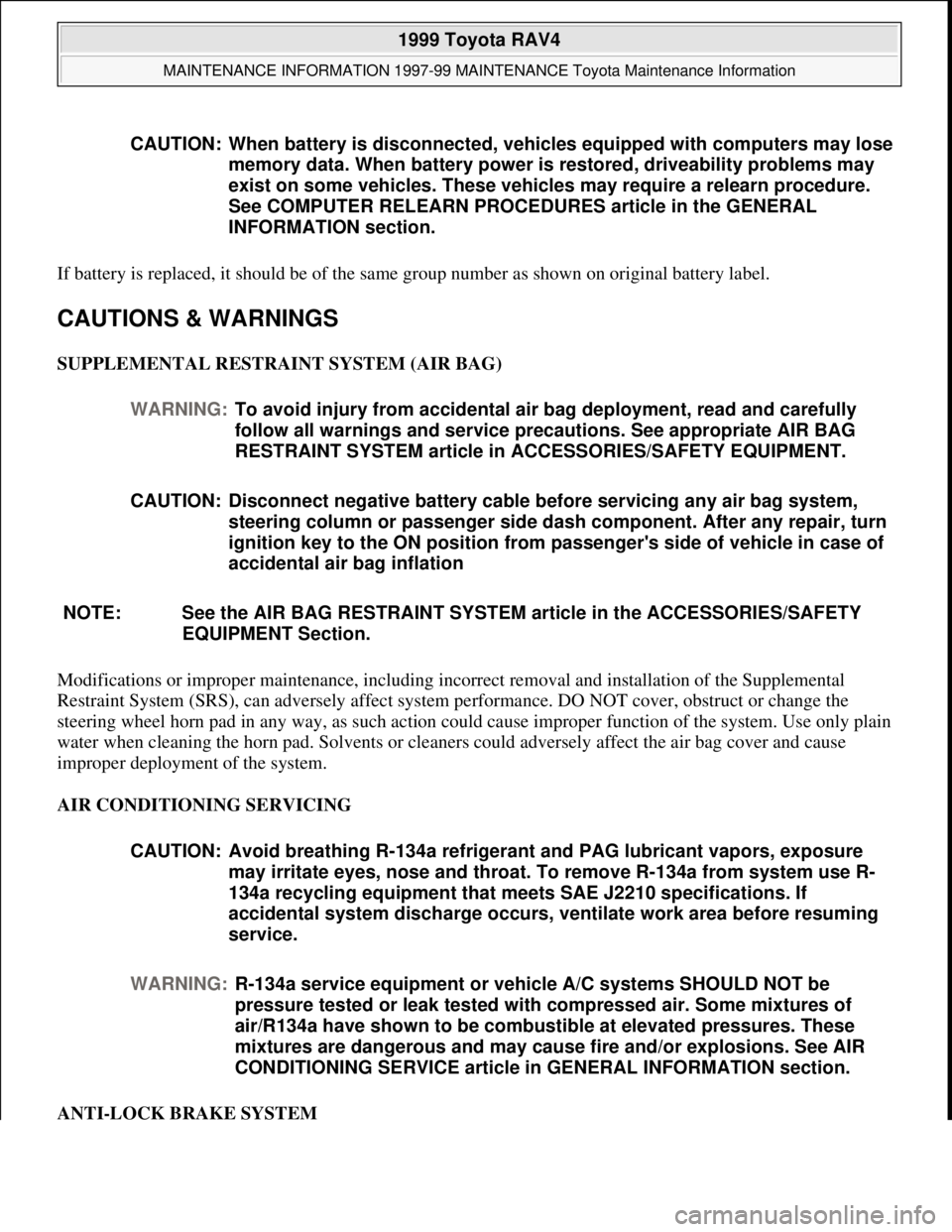
If battery is replaced, it should be of the same group number as shown on original battery label.
CAUTIONS & WARNINGS
SUPPLEMENTAL RESTRAINT SYSTEM (AIR BAG)
Modifications or improper maintenance, including incorrect removal and installation of the Supplemental
Restraint System (SRS), can adversely affect system performance. DO NOT cover, obstruct or change the
steering wheel horn pad in any way, as such action could cause improper function of the system. Use only plain
water when cleaning the horn pad. Solvents or cleaners could adversely affect the air bag cover and cause
improper deployment of the system.
AIR CONDITIONING SERVICING
ANTI-LOCK BRAKE SYSTEM CAUTION: When battery is disconnected, vehicles equipped with computers may lose
memory data. When battery power is restored, driveability problems may
exist on some vehicles. These vehicles may require a relearn procedure.
See COMPUTER RELEARN PROCEDURES article in the GENERAL
INFORMATION section.
WARNING:To avoid injury from accidental air bag deployment, read and carefully
follow all warnings and service precautions. See appropriate AIR BAG
RESTRAINT SYSTEM article in ACCESSORIES/SAFETY EQUIPMENT.
CAUTION: Disconnect negative battery cable before servicing any air bag system,
steering column or passenger side dash component. After any repair, turn
ignition key to the ON position from passenger's side of vehicle in case of
accidental air bag inflation
NOTE: See the AIR BAG RESTRAINT SYSTEM article in the ACCESSORIES/SAFETY
EQUIPMENT Section.
CAUTION: Avoid breathing R-134a refrigerant and PAG lubricant vapors, exposure
may irritate eyes, nose and throat. To remove R-134a from system use R-
134a recycling equipment that meets SAE J2210 specifications. If
accidental system discharge occurs, ventilate work area before resuming
service.
WARNING:R-134a service equipment or vehicle A/C systems SHOULD NOT be
pressure tested or leak tested with compressed air. Some mixtures of
air/R134a have shown to be combustible at elevated pressures. These
mixtures are dangerous and may cause fire and/or explosions. See AIR
CONDITIONING SERVICE article in GENERAL INFORMATION section.
1999 Toyota RAV4
MAINTENANCE INFORMATION 1997-99 MAINTENANCE Toyota Maintenance Information
Microsoft
Sunday, November 22, 2009 10:32:42 AMPage 7 © 2005 Mitchell Repair Information Company, LLC.
Page 950 of 1632
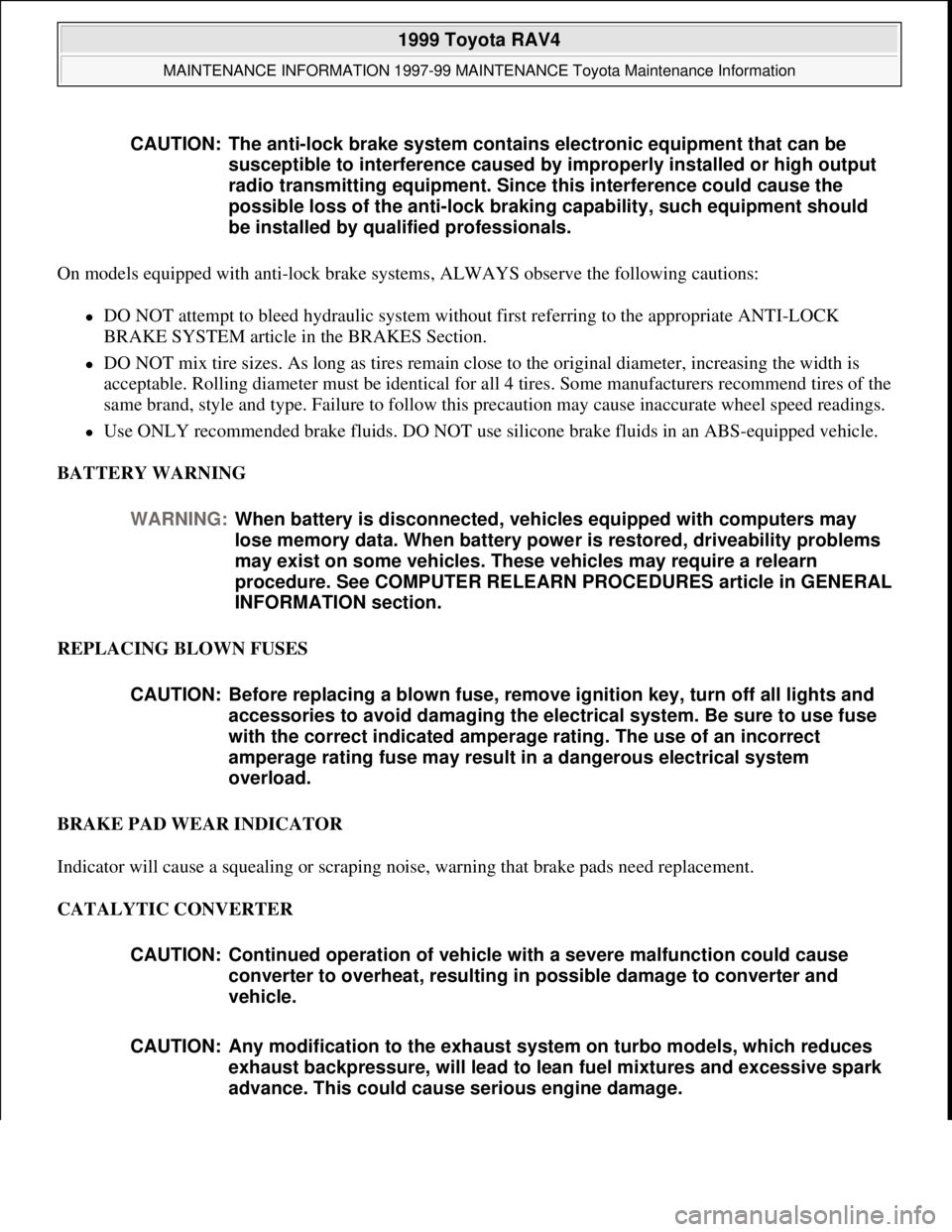
On models equipped with anti-lock brake systems, ALWAYS observe the following cautions:
DO NOT attempt to bleed hydraulic system without first referring to the appropriate ANTI-LOCK
BRAKE SYSTEM article in the BRAKES Section.
DO NOT mix tire sizes. As long as tires remain close to the original diameter, increasing the width is
acceptable. Rolling diameter must be identical for all 4 tires. Some manufacturers recommend tires of the
same brand, style and type. Failure to follow this precaution may cause inaccurate wheel speed readings.
Use ONLY recommended brake fluids. DO NOT use silicone brake fluids in an ABS-equipped vehicle.
BATTERY WARNING
REPLACING BLOWN FUSES
BRAKE PAD WEAR INDICATOR
Indicator will cause a squealing or scraping noise, warning that brake pads need replacement.
CATALYTIC CONVERTER CAUTION: The anti-lock brake system contains electronic equipment that can be
susceptible to interference caused by improperly installed or high output
radio transmitting equipment. Since this interference could cause the
possible loss of the anti-lock braking capability, such equipment should
be installed by qualified professionals.
WARNING:When battery is disconnected, vehicles equipped with computers may
lose memory data. When battery power is restored, driveability problems
may exist on some vehicles. These vehicles may require a relearn
procedure. See COMPUTER RELEARN PROCEDURES article in GENERAL
INFORMATION section.
CAUTION: Before replacing a blown fuse, remove ignition key, turn off all lights and
accessories to avoid damaging the electrical system. Be sure to use fuse
with the correct indicated amperage rating. The use of an incorrect
amperage rating fuse may result in a dangerous electrical system
overload.
CAUTION: Continued operation of vehicle with a severe malfunction could cause
converter to overheat, resulting in possible damage to converter and
vehicle.
CAUTION: Any modification to the exhaust system on turbo models, which reduces
exhaust backpressure, will lead to lean fuel mixtures and excessive spark
advance. This could cause serious engine damage.
1999 Toyota RAV4
MAINTENANCE INFORMATION 1997-99 MAINTENANCE Toyota Maintenance Information
Microsoft
Sunday, November 22, 2009 10:32:42 AMPage 8 © 2005 Mitchell Repair Information Company, LLC.
Page 951 of 1632
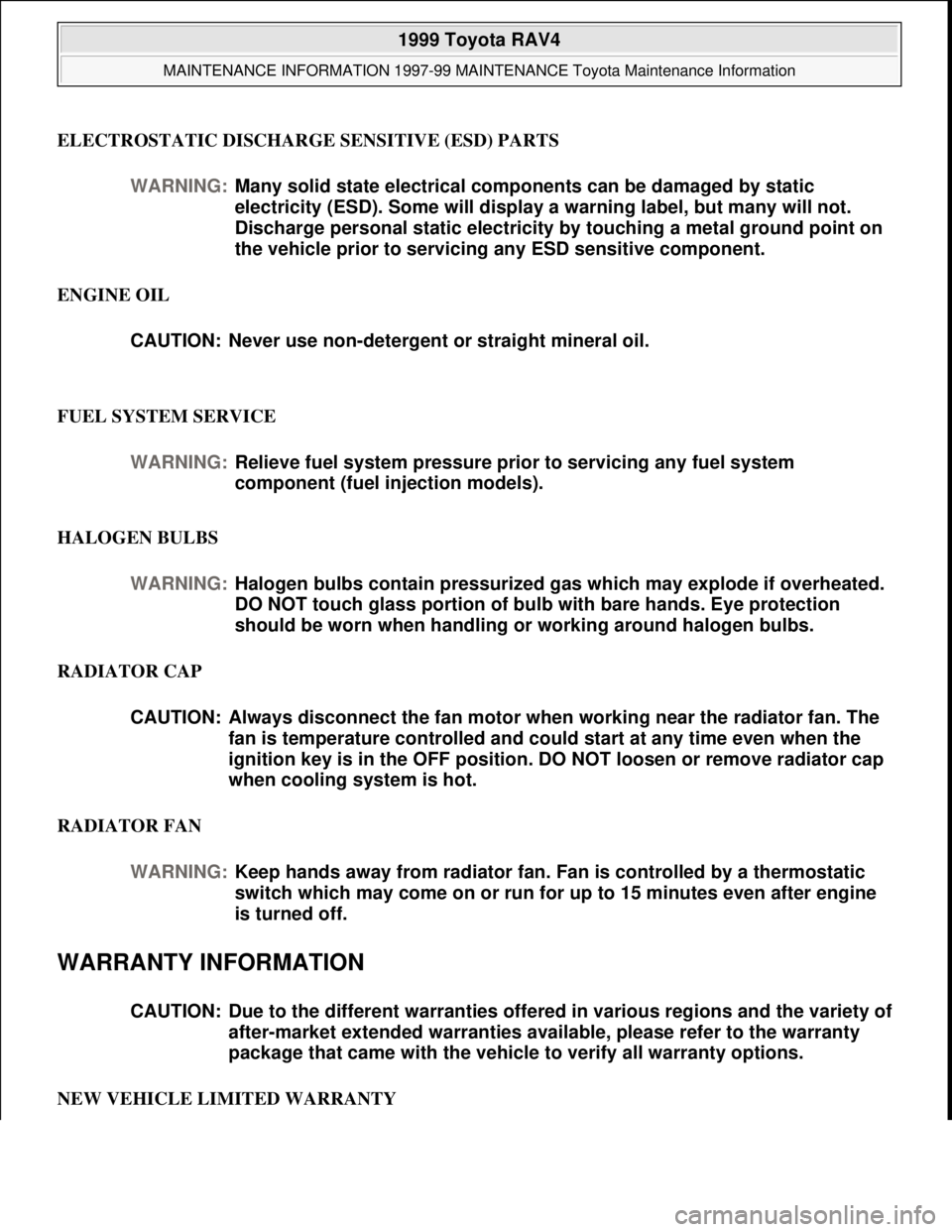
ELECTROSTATIC DISCHARGE SENSITIVE (ESD) PARTS
ENGINE OIL
FUEL SYSTEM SERVICE
HALOGEN BULBS
RADIATOR CAP
RADIATOR FAN
WARRANTY INFORMATION
NEW VEHICLE LIMITED WARRANTY WARNING:Many solid state electrical components can be damaged by static
electricity (ESD). Some will display a warning label, but many will not.
Discharge personal static electricity by touching a metal ground point on
the vehicle prior to servicing any ESD sensitive component.
CAUTION: Never use non-detergent or straight mineral oil.
WARNING:Relieve fuel system pressure prior to servicing any fuel system
component (fuel injection models).
WARNING:Halogen bulbs contain pressurized gas which may explode if overheated.
DO NOT touch glass portion of bulb with bare hands. Eye protection
should be worn when handling or working around halogen bulbs.
CAUTION: Always disconnect the fan motor when working near the radiator fan. The
fan is temperature controlled and could start at any time even when the
ignition key is in the OFF position. DO NOT loosen or remove radiator cap
when cooling system is hot.
WARNING:Keep hands away from radiator fan. Fan is controlled by a thermostatic
switch which may come on or run for up to 15 minutes even after engine
is turned off.
CAUTION: Due to the different warranties offered in various regions and the variety of
after-market extended warranties available, please refer to the warranty
package that came with the vehicle to verify all warranty options.
1999 Toyota RAV4
MAINTENANCE INFORMATION 1997-99 MAINTENANCE Toyota Maintenance Information
Microsoft
Sunday, November 22, 2009 10:32:42 AMPage 9 © 2005 Mitchell Repair Information Company, LLC.
Page 952 of 1632
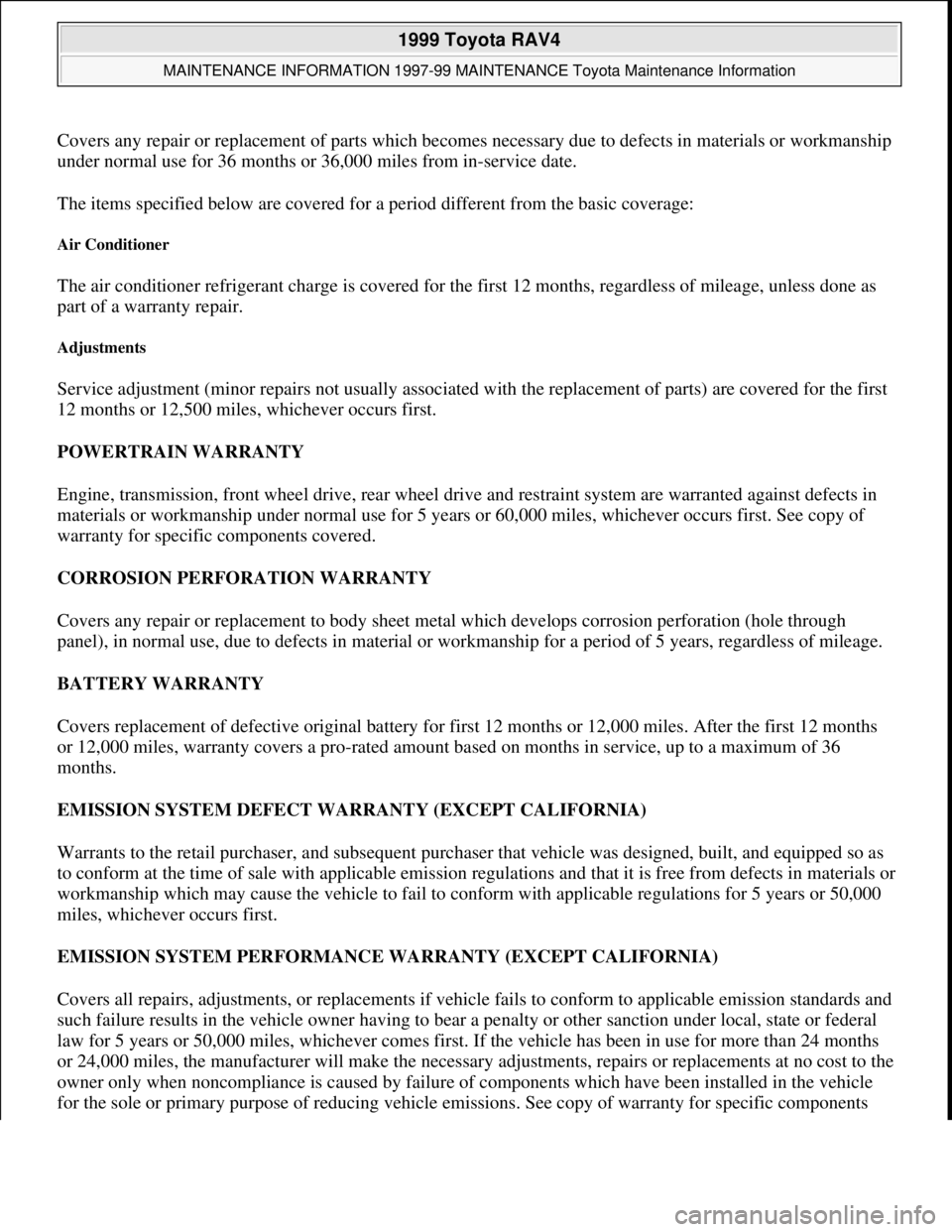
Covers any repair or replacement of parts which becomes necessary due to defects in materials or workmanship
under normal use for 36 months or 36,000 miles from in-service date.
The items specified below are covered for a period different from the basic coverage:
Air Conditioner
The air conditioner refrigerant charge is covered for the first 12 months, regardless of mileage, unless done as
part of a warranty repair.
Adjustments
Service adjustment (minor repairs not usually associated with the replacement of parts) are covered for the first
12 months or 12,500 miles, whichever occurs first.
POWERTRAIN WARRANTY
Engine, transmission, front wheel drive, rear wheel drive and restraint system are warranted against defects in
materials or workmanship under normal use for 5 years or 60,000 miles, whichever occurs first. See copy of
warranty for specific components covered.
CORROSION PERFORATION WARRANTY
Covers any repair or replacement to body sheet metal which develops corrosion perforation (hole through
panel), in normal use, due to defects in material or workmanship for a period of 5 years, regardless of mileage.
BATTERY WARRANTY
Covers replacement of defective original battery for first 12 months or 12,000 miles. After the first 12 months
or 12,000 miles, warranty covers a pro-rated amount based on months in service, up to a maximum of 36
months.
EMISSION SYSTEM DEFECT WARRANTY (EXCEPT CALIFORNIA)
Warrants to the retail purchaser, and subsequent purchaser that vehicle was designed, built, and equipped so as
to conform at the time of sale with applicable emission regulations and that it is free from defects in materials or
workmanship which may cause the vehicle to fail to conform with applicable regulations for 5 years or 50,000
miles, whichever occurs first.
EMISSION SYSTEM PERFORMANCE WARRANTY (EXCEPT CALIFORNIA)
Covers all repairs, adjustments, or replacements if vehicle fails to conform to applicable emission standards and
such failure results in the vehicle owner having to bear a penalty or other sanction under local, state or federal
law for 5 years or 50,000 miles, whichever comes first. If the vehicle has been in use for more than 24 months
or 24,000 miles, the manufacturer will make the necessary adjustments, repairs or replacements at no cost to the
owner only when noncompliance is caused by failure of components which have been installed in the vehicle
for the sole or primary purpose of reducing vehicle emissions. See copy of warranty for specific components
1999 Toyota RAV4
MAINTENANCE INFORMATION 1997-99 MAINTENANCE Toyota Maintenance Information
Microsoft
Sunday, November 22, 2009 10:32:42 AMPage 10 © 2005 Mitchell Repair Information Company, LLC.